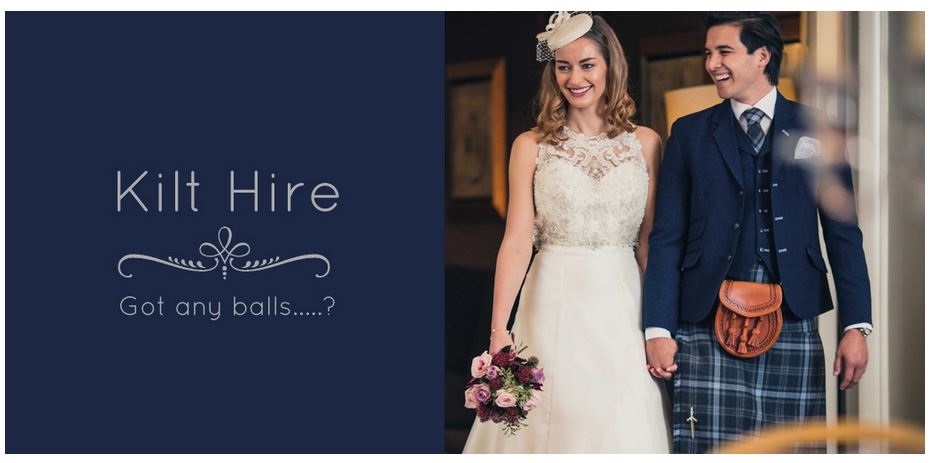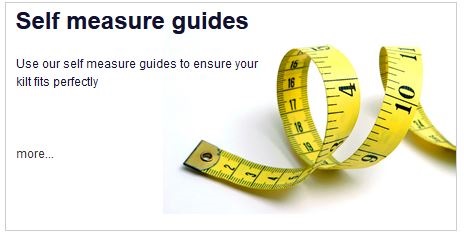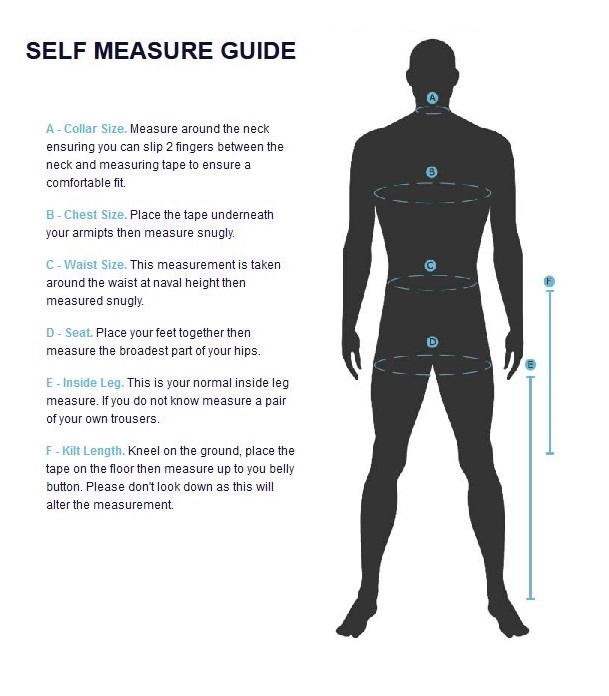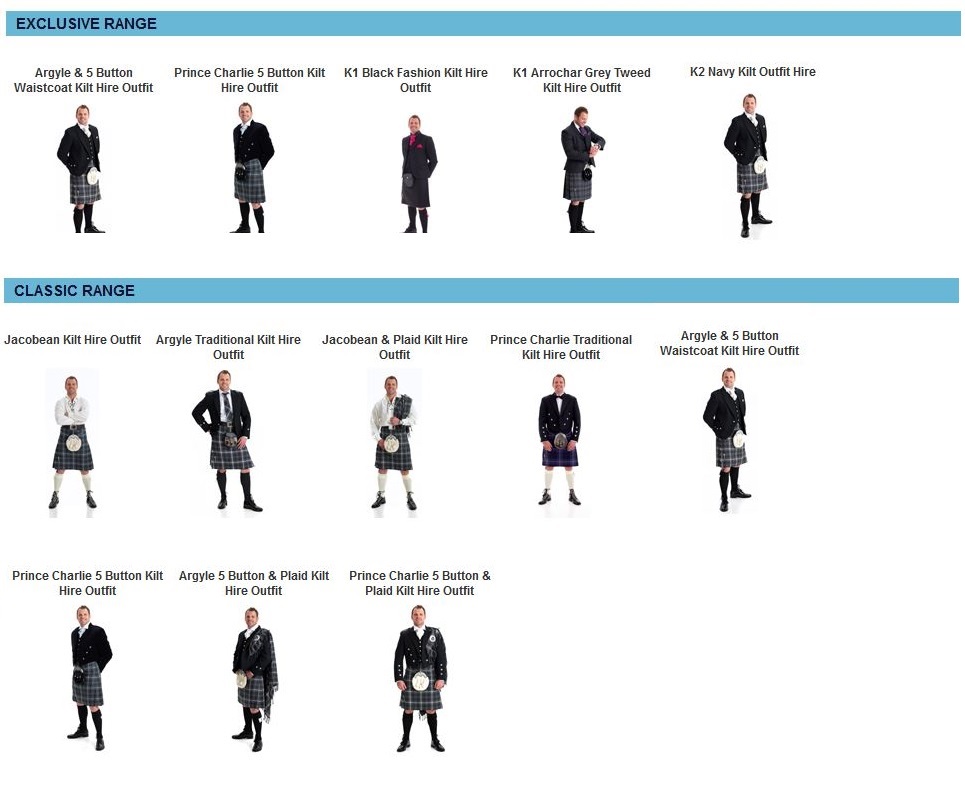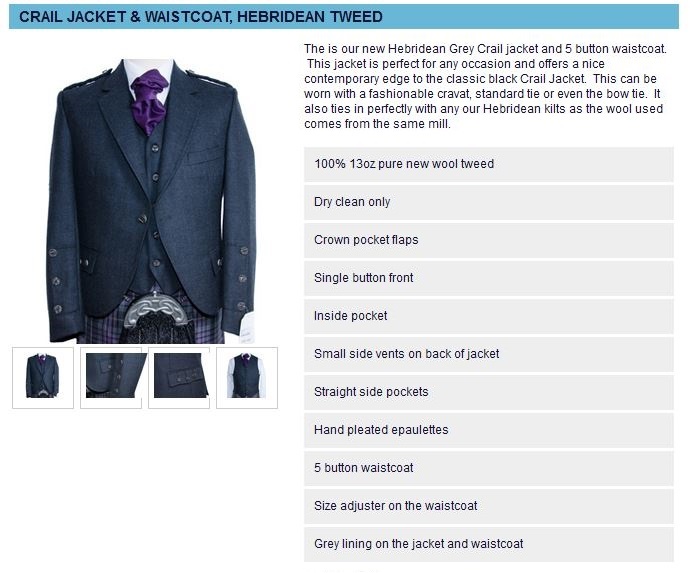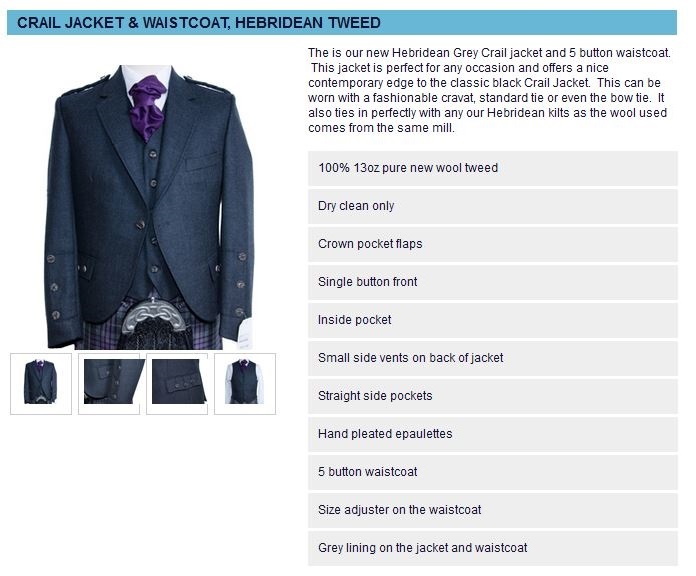The Kilt Store/Inventory
| The Kilt Store Catalogue | |

| |
| Abbreviation: | TKS |
| Group Numbers: | See staff list |
| Leadership: | Kilt Store Owner(in our hearts) |
| Goals: | Kilt Them All! |
| Recruitment Policy: | All Kilted Heroes Welcome |
| Contact: | Nichols Information Center |
Back to the Kilt Store
Full range of men's and woman's attire.
The Kilt Store selling & Hiring Scottish manufactured Highland wear since 2007. We offer a traditional range of Prince Charlie jackets, modern kilt jackets & a Scottish made range of Hand made kilts Proud to support the Highland industries in Malton, since our start up in 2007 we have remained true to the original ethos of buying local & still purchase jackets & trousers from local firms local cloth manufacturers just outside South Blythville & superb local kilt makers hand making our kilts for sale & a top class state of the art kilt manufacturing unit in Malton supplying some of our hire kilts. Sporrans & sporran chains from Stanbury Village Our aim is to have 100% customer satisfaction & great customer service in a busy, modern environment, A family firm with family values with great staff some that have been with us since school & have built up many years of quality sales & Highland wear experience. So whether you are looking to buy a Glencairn whisky glass or a made to measure kilt, they have the skill set and years of knowledge to be help to guide you either through the hire or purchasing process. See how to tie kilt shoe laces the kilt store way Our reputation for keen pricing, quality stock with a commitment to excellent customer service sets us apart from the competition. The Kilt Store Owner and all the team at the kilt store
Measurements
Stitching on the fell of a kilt (Robertson Red Modern)
Although ready-to-wear kilts can be obtained in standard sizes, a custom kilt is tailored to the individual proportions of the wearer. At least three measurements, the waist, hips, and length of the kilt, are usually required. Sometimes the rise (distance above the waist) or the fell (distance from waistline to the widest part of the hips) is also required.
A properly made kilt, when buckled on the tightest holes of the straps, is not so loose that the wearer can easily twist the kilt around their body, nor so tight that it causes "scalloping" of the fabric where it is buckled. Additionally, the length of the kilt when buckled at the waist reaches a point no lower than halfway across the kneecap and no higher than about an inch above it.
Wearing your Kilt
How do I wear kilt hose (socks)?
Put the socks on & pull up your leg to roughly one finger's width below your knee. Keep the lines straight & the socks wrinkle-free!
How do I wear Garter Flashes?
These are usually clip on, and are elasticated to offer some adjustment. Attach round your leg, just below your knee, with the coloured flash to the outside of each leg. Now fold the patterned top of the sock over the garters, leaving around 2” of the flash showing.
Where do I put the Sgian Dubh?
Gaelic for black knife. This is placed inside the sock on the outside of your leg, usually on the side of the hand that you write with, or are quickest with! Around 2” should be left showing over the top of the sock. If you are wearing a real sgian dubh, take care when you take out to show people, as the sheath will stay in your sock & you will be left with an exposed blade.
How do I tie Ghilie Brogues?
These are similar to normal dress brogues, but have no tongue. To tie them: 1. Put on the shoe, tighten, and tie a single knot as you normally would. 2. Keeping this knot tight, run your hands up the lace towards the tassels, keeping the laces taut. 3. Swap hands 6 times, to create a twist in the lace. Pull the laces apart to tighten this to the bottom of the lace, until it is around 2” long. 4. Lay this against your leg and bring the laces around your ankle, just above the ankle bone. Swap hands once at the back and bring the laces back around to the front of your leg. 5. Angle the laces slightly to tie a knot about 1.5” above the twist, and tie a bow as normal. A double knot will help ensure they stay tied during even the most vigorous highland dancing!
How do I tie my tie?
Start with the left end 1 ½" (4 cm) longer than the right end. Slip the short end under the long end. Hint: The extra length (such as 1 ½") depends on the width of the narrow part of the tie, the thickness of the cloth, and whether you want a symmetrical tie. Some people prefer lopsided or tilted ties. Choose how long you want the tie to be. The button is a reference point. Finish crossing the long end over the short end. Slip the long end under the short end, while holding the tie at the button to keep it loose. Zig-zag the end on your chest. One fold is in the wide part of the tie. Zig-zag in progress. Fold the long flap over the front of the tie. Pinch the front of the tie in half. This will let you find a side-to-side hole through the tie, which is hidden behind the front of the tie.
How do I tie my bow tie?
Pinch the right side of the wide part of the tie, while swinging the long flap to the right. Push the pinched corner through the hidden hole. Flatten the right half of the front. Slip a finger into the left bow. Even up the 3 layers of the right half, while pulling the left bow through the hole. Grip all 3 layers on the right, and pull the left bow through the hole. Flatten the left half of the front. Straighten the tie. Hint: Some people prefer lopsided or tilted ties. Tuck the shirt points between the tie's thin strip and the bow tie. Done! To untie, pull the single ends.
How do I tie my cravat?
A cravat isn't as bad as it looks, if you know how to do a tie, then that's how to tie it. Keep the knot looking fairly loose & chunky.
How do I wear my kilt?
Usually cut from 8 yards of fabric,with around 29 pleats which go the rear. This is normally worn around 1” above your belly button & should be firm but not too tight. Start off with the pleats to the back and bring the right-hand panel with the single strap around to the left & feed the strap through the pre-made hole in the kilt & then through into the buckle. Pull this tight & count how many holes used. Now take the left-hand panel & pull across to the right, the top leather strap should go on the same number of hole as the first strap. This helps keep the kilt balanced. If your kilt benefits from a seat strap, fasten this as well, but not tight. This only helps to keep the kilt closed. You know when you have the kilt on correctly when you have the kilt 2.5 cm above your navel & when you look in a mirror & see the bottom half of your knee cap. Now you have to centre the kilt, look for the symmetrical sides of the pattern within the pattern & use that to centre. If this isn't apparent, take the leading front & right edge of the front panel, fold in half & that's your centre.
Where do I put my kilt pin?
The kilt pin is only there for decoration & to add a little weight to the corner of the kilt. The pin should only be put through the front panel of the kilt, usually about 4” up & 2” in from the fringed edge.
How do I wear my waistcoat?
Put this on & fasten all of the buttons. There is an adjuster at the back to tighten the waist if required.
How do I wear my sporran?
This is your man-bag to store all your essential day & night out tools, & should be placed to the front of the kilt, with the straps & chains through the belt loops at the rear of the kilt & fastened like a watch strap. This should centre to the pattern of the kilt & when you put your waistcoat on the top of the sporran should be just below the bottom of the waistcoat.
How do I wear my belt?
This is not a normal addition to the Prince Charlie kilt outfit. But if you intend to take the jacket & waistcoat off it completes the look & finishes the top of the kilt off. This fits through the belt loops at the rear of the kilt & fastens at the front of the kilt. It is normally worn at the top of the kilt & again centres up to the sporran & the pattern of the kilt. Ensure that there is at least 2.5 cm gap between the top of the sporran & the buckle to prevent damage to either. Jacket Put the jacket on as normal. This style does not fasten does, but should feel comfy & have the correct sleeve length for you.
How do I wear my Plaid & brooch?
This is for decoration & is normally worn over the left shoulder. Fold the plaid from corner to corner & pull through the epaulette on the shoulder of the jacket & pull down so that it reaches the bottom button on the front of the jacket. The rest of the plaid will then drape at the rear of the jacket Brooch This is pushed gently through the jacket & plaid. It usually helps to twist through the cloth as pushing could damage both parts.
A kilt can be pleated with either box or knife pleats. A knife pleat is a simple fold, while the box pleat is bulkier, consisting of two knife pleats back-to-back. Knife pleats are the most common in modern civilian kilts. Regimental traditions vary. The Argyll and Sutherland Highlanders use box pleats, while the Black Watch make their kilts of the same tartan with knife pleats. These traditions were also passed on to affiliated regiments in the Commonwealth, and were retained in successor battalions to these regiments in the amalgamated Royal Regiment of Scotland.
Pleats can be arranged relative to the pattern in two ways. In pleating to the stripe, one of the vertical stripes in the tartan is selected and the fabric is then folded so that this stripe runs down the center of each pleat. The result is that along the pleated section of the kilt (the back and sides) the pattern appears different from the unpleated front, often emphasising the horizontal bands rather than creating a balance between horizontal and vertical. This is often called military pleating because it is the style adopted by many military regiments. It is also widely used by pipe bands.
In pleating to the sett, the fabric is folded so that the pattern of the sett is maintained and is repeated all around the kilt. This is done by taking up one full sett in each pleat, or two full setts if they are small. This causes the pleated sections to have the same pattern as the unpleated front.
Any pleat is characterised by depth and width. The portion of the pleat that protrudes under the overlying pleat is the size or width. The pleat width is selected based on the size of the sett and the amount of fabric to be used in constructing the kilt, and will generally vary from about 1/2" to about 3/4".
The depth is the part of the pleat which is folded under the overlying pleat. It depends solely on the size of the tartan sett even when pleating to the stripe, since the sett determines the spacing of the stripes.
The number of pleats used in making kilts depends upon how much material is to be used in constructing the garment and upon the size of the sett.
The pleats across the fell are tapered slightly since the wearer's waist is usually narrower than the hips and the pleats are usually stitched down either by machine or by hand.
In Highland dancing, it is easy to see the effect of the stitching on the action of a kilt. The kilt hugs the dancer's body from the waist down to the hipline and, from there, in response to the dancer's movements, it breaks sharply out. The way the kilt moves in response to the dance steps is an important part of the dance. If the pleats were not stitched down in this portion of the kilt, the action, or movement, would be quite different.
Kilt accessories
The Scottish kilt is usually worn with kilt hose (woollen socks), turned down at the knee, often with garters and flashes, and a sporran (Gaelic for "purse": a type of pouch), which hangs around the waist from a chain or leather strap. This may be plain or embossed leather, or decorated with sealskin, fur, or polished metal plating.
Other common accessories, depending on the formality of the context, include:
A belt (usually with embossed buckle) A jacket (of various traditional designs) A kilt pin A sgian-dubh (Gaelic: "black knife": a small sheathed knife worn in the top of the hose) Ghillie brogues Occasionally worn with a ghillie shirt, although this is more casual and, being a relatively modern invention, shouldn't be confused with actual historic garments.
